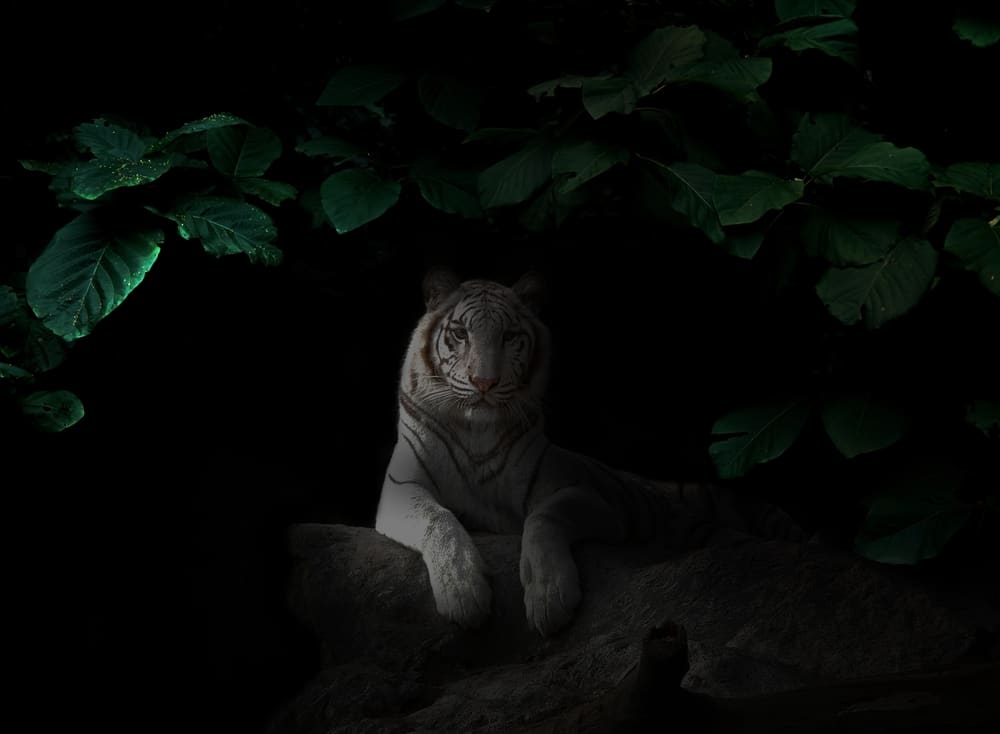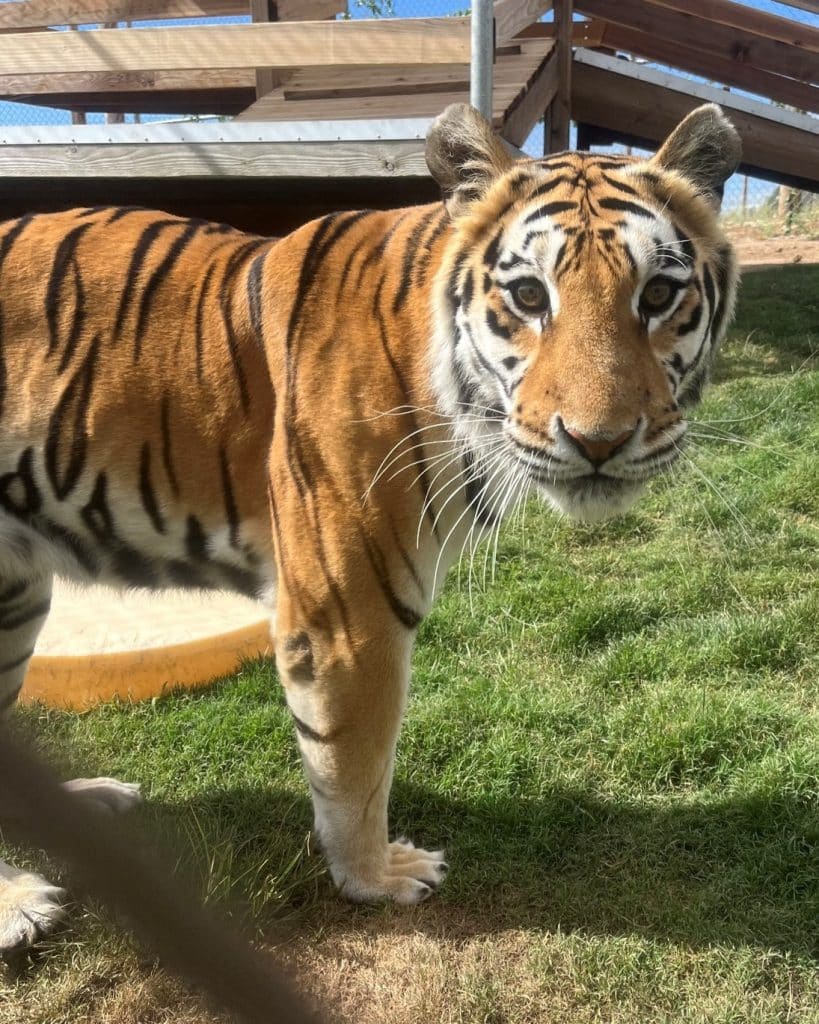A Day in the Life of a Majestic Tiger


The majestic tiger is among the world’s most beautiful apex predators, with their thick, orange-black coats, imperial mien, and huge, neck-snapping paws. They are also intelligent and boast a remarkable memory. In fact, according to research, tigers’ short-term memory is significantly better than that of humans, and other animals. These majestic creatures are truly awe-inspiring.
In this article, we’ll look at the typical tiger’s daily life, including their lifestyle, daily routines, and adaptation skills that enable them to thrive in various environments. We’ll also cover some tiger facts that are worth noting.
Tigers during the Day
Contrary to common belief, tigers are not diurnal creatures. They are crepuscular, meaning they are most active during the dawn and dusk. The daytime, however, is not devoid of activity for the magnificent keystone species.
In the early morning, a tiger often finds a secluded spot, well-hidden in the underbrush or tall grass, to rest. Their strong body comes to rest as the tiger assumes a state of repose. During the day, tigers primarily engage in a favorite pastime — sleep.
Tigers sleep anywhere between 18 to 20 hours every single day. This may seem surprising for such powerful creatures, but there are valid reasons behind their daytime slumber:
- First, sleeping during the day helps tigers avoid conflicts with humans. As human and tiger habitats increasingly overlap, this adaptation allows these majestic creatures to minimize encounters with people, reducing the potential for disputes and ensuring their safety.
- Secondly, a tigers’ prey is often more active during the night. So, when a tiger rests during the day, it synchronizes its hunting routine with its prey, including various ungulates and other animals that are more active during the cooler, nocturnal hours. This strategy gives tigers a higher chance of successful hunts.
Tigers at Night
Tigers become active at night. This is when they set out to hunt, patrol their territories, and even mate.
Hunting under the Cover of Darkness:
Tigers hunt at night. Their environmental adaptations, including exceptional night vision, acute hearing, and an acute sense of smell, make them formidable hunters under darkness. Tigers’ eyesight is six times better than humans in the dark. Tigers also have distinctive orange coats and dark stripes that blend seamlessly into their environment.

With stealth and precision, tigers embark on their prowling behavior. Using the element of surprise to their advantage, they stalk their prey, relying on their muscular bodies and powerful limbs for a sudden burst of speed and a lethal pounce. Tigers hunt about once a week and eat as much as 34 kilograms (75 pounds) of food in one night. Their prey consists of wild boar and deer, but they also eat buffalo, sloth bears, reptiles, fish, birds, and insects.
Territory Marking and Patrol
In addition to hunting, the night is a time for tigers to assert their dominance and defend their territories. Tigers lead a solitary lifestyle, and each individual has a defined home range they patrol regularly. At night, a tiger may embark on territorial patrols, marking its boundaries with scent markings (urine and feces) and scratches on trees.
The urine scent can last up to 40 days and serves as a warning to potential rivals and a signal to potential mates. And their deep, resonant roars can carry over long distances, acting as an audible declaration of their presence in the darkness.
Socializing and Mating
For those tigers seeking companionship, the night can also be a time for socializing and mating. Tigers are generally solitary animals, except when raising young or mating. During the breeding season, males may actively seek out females. Their deep, rumbling vocalizations become a means of communication, allowing them to locate and attract potential mates in the vast darkness of the jungle.
Mating can happen anytime, though it mainly occurs between November and April when the weather is cool. Female tigers only release eggs after mating, and their gestation lasts about 100 days, after which they birth between 1 and 7 cubs.
When cubs are born, they stay with their mothers until they can hunt successfully. That’s usually around 18 to 24 months. The young ones reach complete independence at around year 2 or 3, at which point they move out to find their territory. Females tend to find territories nearby, while males move further from home. And their mothers can mate again.
Tigers in the wild live for 10 to 15 years. But in some cases, they can get to 20 years. Sadly, about 50% of all wild tiger cubs don’t survive beyond 2 years, and only 40% of those that reach adulthood live to establish a territory and sire offspring. The mortality rates are high for adults because of their territorial nature, which leads to direct competition. Other factors like poaching, human-tiger conflicts, diminishing resources, etc., also play a part.
Observation and Facts from LTB
Our dedicated team at Lion Tigers & Bears engages in routine observation of tigers under our care to gain valuable insights into the natural behaviors of these big cats. Through meticulous study and documentation, we uncover essential facts that contribute to our understanding of tigers and aid in their rescue and recovery.

Our observations confirm the significance of territoriality in their behavior. We have documented tigers’ meticulous marking and patrolling activities, providing valuable data that enhances our understanding of their territorial needs. This knowledge is crucial for designing habitats for the big cats.
We’ve also found that providing mentally stimulating environments, such as puzzle feeders and varied landscapes, helps mimic the challenges of their natural habitats, fostering a more enriched and satisfying life for these captive tigers.
Our observations highlight the importance of replicating diverse environments, including water features and vegetation, to cater to the tigers’ preferences. This attention to detail enhances the overall welfare of the animals and contributes to a more authentic representation of their natural habitats.
Only six of the nine tiger subspecies have survived, and those that did are all critically endangered. The critical state of these majestic creatures underscores the need for collective efforts to understand, preserve, and protect them.
Let us stand united in our resolve to protect tigers and their habitats, working hand in hand to secure a future where these majestic creatures thrive in the wild. Together, we can be the catalysts for positive change and impact the rescue and conservation of endangered species.